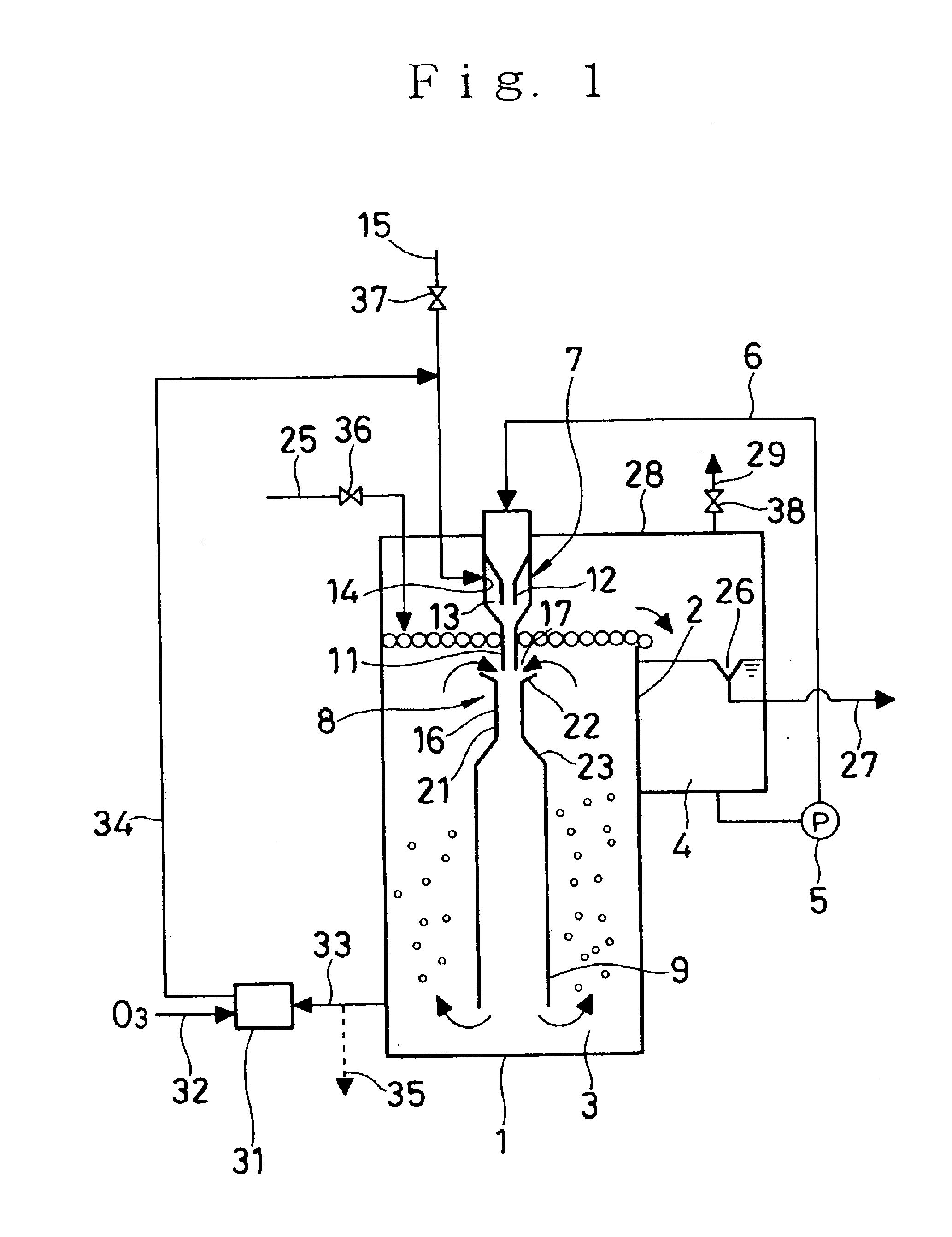Apparatus and process for aerobic digestion of organic sludge
a technology of organic sludge and aerobic digestion, which is applied in the direction of filtration separation, multi-stage water/sewage treatment, separation process, etc., can solve the problems of clogging trouble, difficulty in cleaning work, so as to prevent clogging of oxygen-containing gas supply lines and facilitate digestion.
- Summary
- Abstract
- Description
- Claims
- Application Information
AI Technical Summary
Benefits of technology
Problems solved by technology
Method used
Image
Examples
example 1
[0117]An organic sludge was treated by aerobic digestion using the apparatus as shown in FIG. 1. Thus, an excess sludge delivered from a waste water treating plant (by the so-called activated sludge method) for treating food industry waste water was subjected to a high-temperature aerobic digestion at a temperature in the range from 50 to 60° C. in a high-temperature aerobic digestion tank having a capacity of 2,000 liters. A part of the sludge liquor in the digestion tank was extracted by a pump at a rate of 200 ml / min and is brought into contact with an amount of an ozone gas (having an ozone concentration of 40 mg / N liter) corresponding to 3%, with respect to the weight of the VSS of the sludge, to modify it. The gas / liquid mixed flow resulting from the modification reaction was supplied as such to a liquid / gas ejector (having a nozzle diameter of 8 mm, with a downward directing pipe having a length of 3.5 m and a diameter of 36 mm). Under such a sucking pressure built up by the ...
examples 2 to 4
[0118]Aerobic digestion of organic sludge was carried out under the same conditions as in Example 1 except that each an apparatus given in each of FIGS. 2 to 4 was employed, respectively. Aspiration of atmospheric air by the liquid / gas ejector was incorporated at a rate of 1.2 Nm3 / min and the time interval until the gas supply rate had decreased to 0.8 Nm3 / min was determined. The results are recited in Table 1.
reference example 1
[0123]For the aerobic digestion, use of the liquid / gas ejector was dispensed with and conditions as given in the following 1) to 8) were employed:[0124]1) The sludge: a concentrated sludge obtained by centrifugation of an excess sludge delivered from a waste water treating plant (by the so-called activated sludge method) for treating food industry waste waster.[0125]2) Concentration of the feed sludge: 35,000 to 42,000 mg / liter as MLSS concentration.[0126]3) Feed rate of the sludge: 150 liters per day; introduced into the digestion tank.[0127]4) Capacity of the digestion tank: 2,000 liters.[0128]5) Ozone treatment: The sludge liquor in the digestion tank was extracted continuously at a rate of 200 ml / min, which was subjected to an ozone treatment after having been adjusted at a pH of 3.0-3.5 with sulfuric acid, before being returned to the digestion tank. The rate of supply of ozone was 3%, with respect to the weight of the VSS.[0129]6) Preconditioning of the sludge: The sludge was ...
PUM
| Property | Measurement | Unit |
|---|---|---|
| temperature | aaaaa | aaaaa |
| temperature | aaaaa | aaaaa |
| temperature | aaaaa | aaaaa |
Abstract
Description
Claims
Application Information
 Login to View More
Login to View More - R&D
- Intellectual Property
- Life Sciences
- Materials
- Tech Scout
- Unparalleled Data Quality
- Higher Quality Content
- 60% Fewer Hallucinations
Browse by: Latest US Patents, China's latest patents, Technical Efficacy Thesaurus, Application Domain, Technology Topic, Popular Technical Reports.
© 2025 PatSnap. All rights reserved.Legal|Privacy policy|Modern Slavery Act Transparency Statement|Sitemap|About US| Contact US: help@patsnap.com



